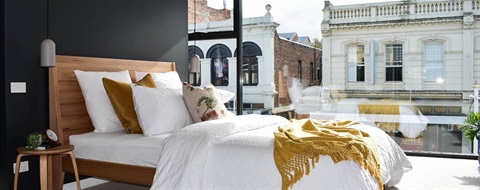The Development Process

Like many Australian towns and cities, Launceston has unused spaces in its centre, particularly the spaces above the shops, and these provide great opportunities for city revitalisation.
We aim to bring residents into the city, in order for Launceston to become:
- a more vibrant city with an improved economy;
- a more condensed city with minimised suburban sprawl; and
- an even safer city, because there will be, simply, ‘more people about’.
Progress toward these goals is strong, in terms of both public policy and community values – and now we need people with vision to turn it into a reality. The opportunity is an initiative of the City of Launceston. It is, in short, an offer of support for investment in residential accommodation on upper floors in the CBD – combining worthwhile investment with far-reaching benefits to the Launceston community.
The opportunity for owners and developers
The response may be either the conversion of unused (or under- used) upper level space in existing city centre buildings or the development of the remaining small pockets of vacant land for residential and/or commercial uses.
Benefits to the building or land owner may include:
- income from currently unprofitable upper level real-estate;
- improved security for investments; and
- an increase in property values.
Existing building stock
Maintenance of city buildings is a persistent issue for property owners. Damage caused by water (leaking roofs, tanks or pipes), pest infestations or criminal activity can easily go undetected when buildings are unoccupied outside business hours. Major (and expensive) damage to entire buildings can result. When buildings are occupied by residents, such events are less likely to occur, and less likely to lead to major damage if they do occur.
Residential demand
There are both lifestyle and financial advantages for people making the move into the city, and an investment opportunity in providing that accommodation.
Household sizes are decreasing and the inner city appeals to a diverse range of people. Students, singles and ‘empty-nesters' are discovering both the convenience of living in the city and the dynamic lifestyle that it affords – so there are a variety of markets to consider targeting.
University students seek affordable accommodation close to public transport and active social centres. In Launceston, demand for accommodation among both local and international students appears strong. It is likely that the growth of the University of Tasmania campus at Inveresk will increase demand for housing in the inner suburbs and city centre.
Council support
The City of Launceston's strategic plan, the Greater Launceston Plan, encourages living in the city centre. Planning Scheme provisions have been designed to allow residential development to occur on upper levels. Planning approval for a change of use is nonetheless normally required. This is sought through a Development Application process. We recommend you talk to a Planner at the Council early in the planning process. They can provide guidance in regard to the relevant planning provisions before you engage consultants, and assist you with making an application when required.
- Zoning and permitted land use
Single and multiple dwellings above ground floor level are classified as 'Permitted with a Permit' in the zones that cover most of the central city area – the Central Business and Urban Mixed Use zones.
On-site parking requirements are waived in the centre of the city. This is an area defined in the Planning Scheme as the Central Business Parking Exemption Area.
Changes to heritage listed properties will normally require specific approval. The Council's Heritage Planner can assist you with this process.